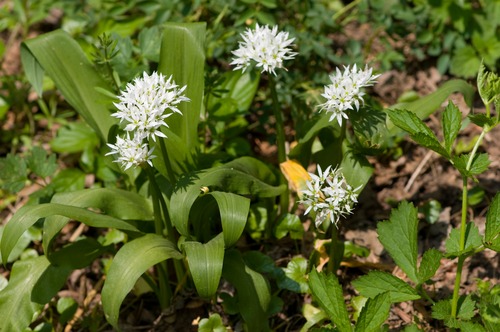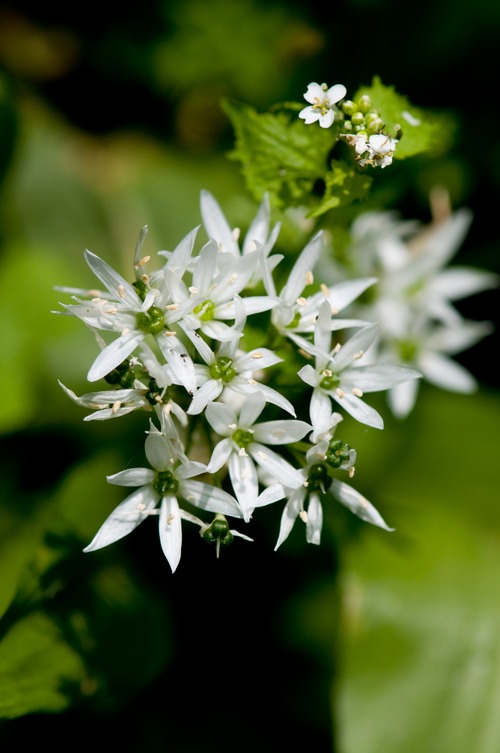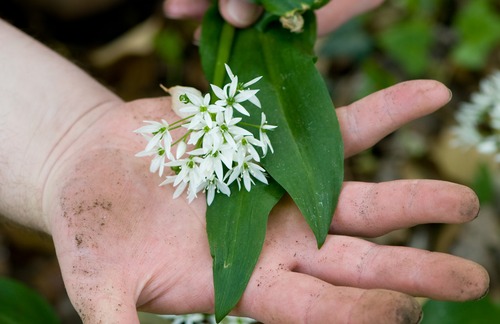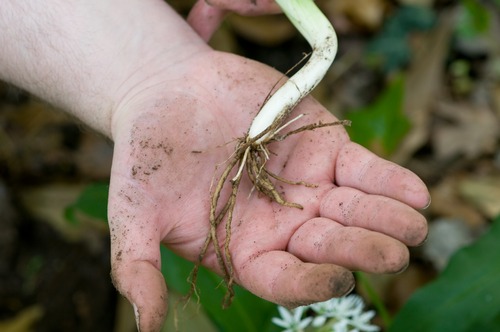

Ramsons (Allium ursinum)
Ramsons (Allium ursinum) is a woodland-loving plant, wshich often frequent areas close to water. During the months of April through to June Ramsons, or Wild Garlic as it’s more frequently named, carpets woodland floors with a fantastic display of white globe-like heads, which are formed of many smaller star-shaped flowers. One may say that it’s a little too abundant to be a wild food, as when you find this species; the chances are there will be lots and lots of the stuff, often forming patches of several acres in size! But for the forager, this is a treat that is simply too good to pass up.

Ramsons Flowers
Wild garlic is probably among the easiest of all British wild foods to identify. Usually a simple intake of air is enough to know its located close by, and from then in, a simple crushed leaf will emit a pungent aroma of the familiar garlic bulbs which are bought in the shops – enough to aid identification alone in my opinion!
Another species which produces the garlic-like aroma is Jack-By-The-Hedge (Alliaria petiolata) but you can’t really compare two in the same class, the pungency and strong flavour of Ramsons far surpasses that of its similar counterpart, both are edible so confusion between the two is not a fatal error, but the appearance is quite different nevertheless.
One plant which must not be confused with Ramsons is that of Lily of the Valley (Convallaria majalis). The leaves appear quite similar on both species, but remember Lily of the Valley lacks the garlic scent. The flowers of both species differ in the way they are presented, the toxic Lily of Valley has flowers which do not form globes, although they are white.
Ramsons have some fantastic edible qualities, and for this reason it has to be viewed as one of the best wild foods to flavour and accompany other dishes.
LEAVES – the long green leaves have a slightly milder flavour than the garlic bought in shops, but it’s still very flavoursome. These are best chopped and soften in butter with other ingredients to add flavour, or used in mixed salads.
FLOWERS – many will leave the flowers alone, but for me these are the best bit, offering a sweet but very power flavour which leaves you with a peppery kick. These are fantastic to add as a garnish to salads, lamb, or even to float on the top of soup.

SEED PODS – these are edible too! But they do become very strong in flavour as they mature.
BULB/ROOT – this is the part we would traditionally buy in a shop, and although Ramsons is known as wild garlic, in truth it’s closer to a wild spring onion, so the bulb will resemble this. These roots are fantastic treats, and although they can be a fiddle to dig up, it is more than worth it! Simply chop into salads or cut into thin slivers and add to good quality olive oil with a squeeze of lemon juice and some flaked salt.


Erik Blums on 03/05/13
I last year introduced wild garlic into the side or a very deep irrigation ditch that is well shade by deciduous trees. I only had about a dozen plants and all seem to have taken to their new home.
As i understand it, if I harvest the whole plant this year, that will be the end of it. Not a biggy, but I sure would like some this year!
Many herds can have the leaves partially harvested and they continue to grow, pushing out new leaves.
If I harvest one or two of the (3?) leaves, will the build continue to thrive so that my patch continues to thrive and expand?
Also, I read that it in addition to relying on natural reproduction, I can harvest, split and replant the bulbs but, apparently, only in the second year as the bulb will be (too) small the first year.
Can anyone advise? Will the bulb be too small to make splitting EASY or will the VIABILITY of the bulb be adversely affected if I split it the first year?
Thanks in advance!
Sarh Devon 26/04/2012 on 26/04/12
I made a delicious wild garlic risotto with the flowers added at the end for maximum flavour and crunch. I would never dig up the bulbs even though there is such a plentiful supply in our local woods
Karen on 13/11/11
Here in the US we have the Allium tricoccum. Some areas are over harvested in spring for gourmet restaurants and there is talk of limiting the harvest. As a family of three, we only gather what we can possibly eat in a sustainable manner by cutting the leaves in spring, and not bothering the bulbs unless we have a very specific need for them. The 3 Foragers
Lars Jalking (Denmark) on 03/11/11
One of my favorites, and apart from being a great seasoning to your food it's one of the most powerfull sources of vitamin C you can find in the forest.
Cheers
Ian McRae on 19/05/19
Just had my first lot of leaves in a salad. Absolutely delicious. Garlicky, but not as strong a proper garlic. The flowers make a lovely garnish sprinkled on the top. I'll try the seeds later when they come, might be good in cooking if they are as said stronger as they mature. Thanks for this helpful page.